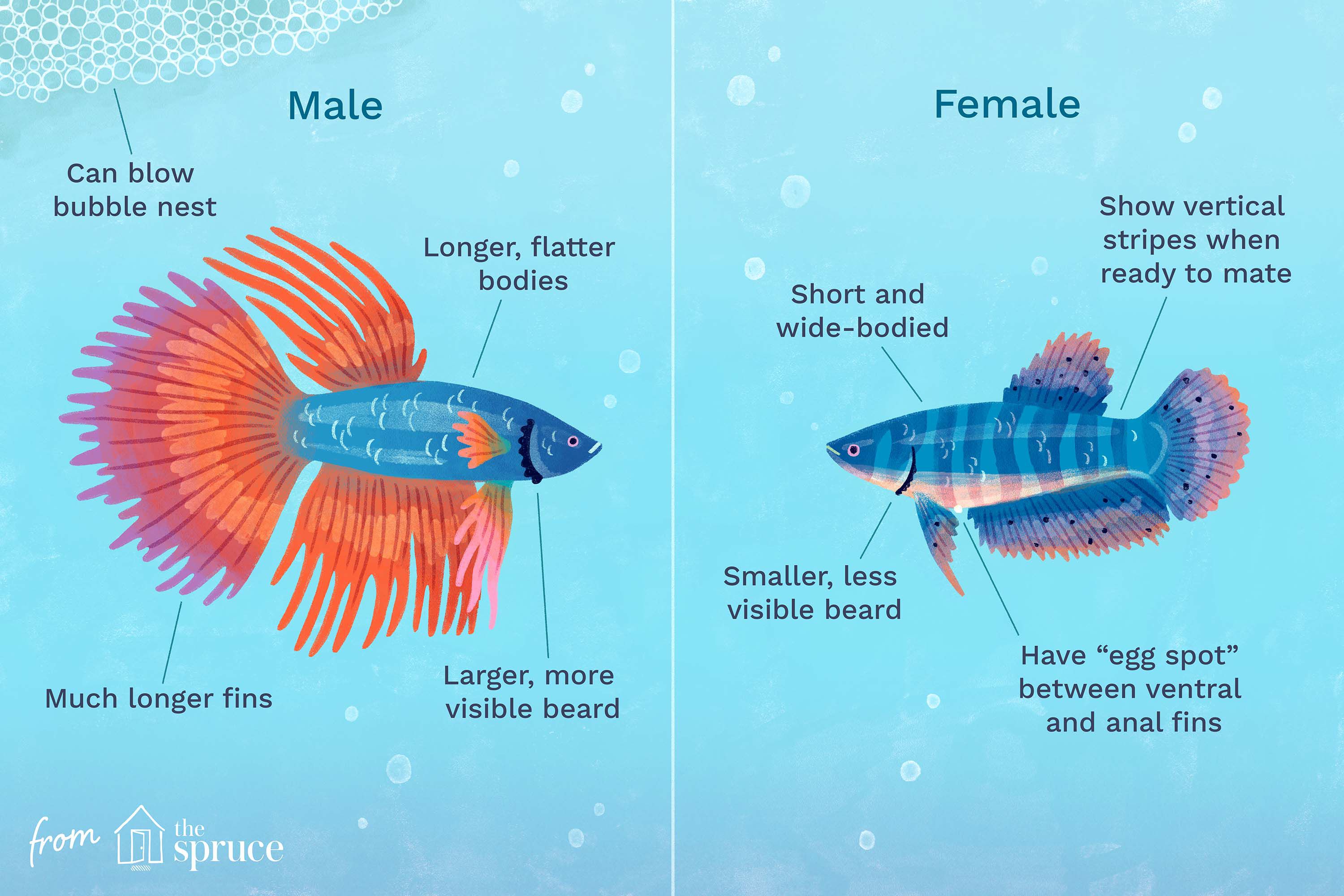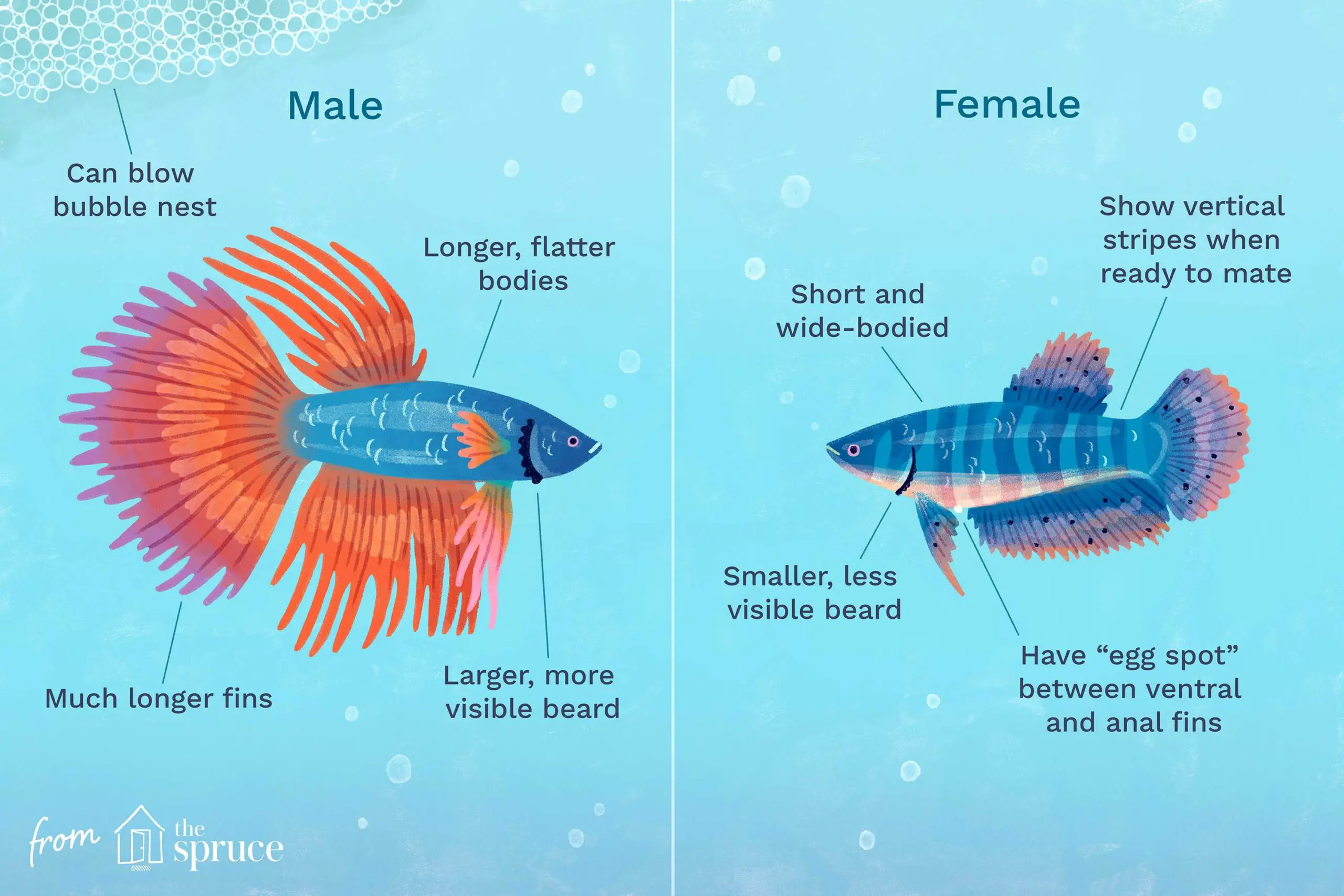Originally posted on May 12, 2023 @ 1:00 pm
Last Updated on 6 months by admin
Butterfly Betta fish are a stunning addition to any aquarium, with their vibrant colors and graceful movements. However, if you are a Betta fish enthusiast, you may be wondering how to differentiate between male and female butterfly Betta fish. In this article, we will discuss the physical characteristics that distinguish these two genders, as well as some tips to help you care for your Betta fish properly.
Whether you are a beginner or an experienced Betta fish keeper, understanding the differences between male and female butterfly Betta fish is essential for their health and well-being. By the end of this article, you will be equipped with the knowledge needed to identify the gender of your Betta fish and provide them with the proper care they need to thrive. Let’s dive in!
To differentiate between male and female butterfly betta fish, look at the size and color of their fins. Male butterfly bettas have larger and more elaborate fins, while female butterfly bettas have smaller and more rounded fins. Additionally, male butterfly bettas are typically more vibrant in color compared to their female counterparts. It’s important to note that these differences may not be apparent until the fish mature, which usually happens at around four to six months old.

How to Differentiate Male and Female Butterfly Betta Fish
If you’re a proud owner of a Butterfly Betta Fish, you may have wondered whether it’s a male or female. It’s not always easy to distinguish between the two, but with a little knowledge and practice, you can learn to tell them apart. In this article, we’ll take a closer look at the differences between male and female Butterfly Betta Fish and how to identify them.
Physical Characteristics
One of the most obvious ways to differentiate between male and female Butterfly Betta Fish is by their physical characteristics. Males are typically larger and have longer, flowing fins. They also have brighter and more vibrant colors than females. Females, on the other hand, are smaller and have shorter fins. Their colors tend to be less vibrant, with a more subdued appearance.
Another way to tell the difference is by looking at their body shape. Males have a more streamlined and sleek body shape, while females have a rounder and fuller body shape. The male’s body is also more elongated, while the female’s body is more compact.
Behavioral Differences
Aside from physical characteristics, male and female Butterfly Betta Fish also have behavioral differences that can help you identify their sex. Males are known for their aggressive behavior, especially towards other males. They will often flare their fins and display their vibrant colors to intimidate their rivals. Females, on the other hand, are generally more peaceful and social. They will usually get along well with other fish in the tank.
Another way to tell the difference is by observing their breeding behavior. Males will often build bubble nests on the surface of the water, using saliva and bubbles to create a floating structure. They will also court the female by swimming around her and flaring their fins. Females, on the other hand, will lay eggs in the nest and take care of the young once they hatch.
Dietary Differences
Male and female Butterfly Betta Fish also have dietary differences that can help you identify their sex. Males require a diet that is high in protein to maintain their vibrant colors and long fins. They also need a varied diet that includes live or frozen foods such as brine shrimp or bloodworms.
Females, on the other hand, have different dietary needs. They require a diet that is high in vitamins and minerals to support their reproductive system. They also need a diet that is rich in calcium to help them produce healthy eggs. A balanced diet of pellets and vegetables is ideal for female Butterfly Betta Fish.
Caring for Male and Female Butterfly Betta Fish
Caring for male and female Butterfly Betta Fish is similar in many ways. Both sexes require a clean and well-maintained tank with appropriate water parameters. They also need a varied diet that meets their nutritional needs.
One thing to keep in mind is that male Butterfly Betta Fish are more prone to stress and aggression, especially if they are kept in a small tank or with other males. To prevent stress and aggression, provide them with plenty of hiding places and a tank that is at least five gallons in size.
Female Butterfly Betta Fish are generally more social and can be kept together in larger groups. However, it’s important to monitor their behavior and make sure they are not becoming aggressive or territorial.
Benefits of Owning Male and Female Butterfly Betta Fish
Owning male and female Butterfly Betta Fish can be a rewarding experience for any fish enthusiast. Males are known for their stunning colors and long flowing fins, making them a popular choice for aquariums. They are also fascinating to watch as they build bubble nests and court their female counterparts.
Females, on the other hand, are great for community tanks and can add a peaceful and social element to your aquarium. They are also excellent parents and will care for their young once they hatch.
Conclusion
In conclusion, differentiating between male and female Butterfly Betta Fish may seem daunting at first, but with a little knowledge and practice, it can be easy. By observing their physical characteristics, behavioral differences, and dietary needs, you can identify their sex and provide them with the appropriate care.
Remember to provide your male Butterfly Betta Fish with plenty of hiding places and a large enough tank to prevent stress and aggression. Female Butterfly Betta Fish can be kept in larger groups, but it’s important to monitor their behavior and make sure they are not becoming aggressive or territorial.
Overall, owning male and female Butterfly Betta Fish can be a rewarding and fascinating experience that will add color and life to your aquarium.
Frequently Asked Questions
Here are some common questions related to differentiating male and female butterfly betta fish.
How can you tell the difference between a male and female butterfly betta fish?
One way to differentiate between a male and female butterfly betta fish is by looking at their size and fins. Male bettas are usually bigger in size and have longer fins than females. Another way to distinguish between the two is by observing their behavior during breeding. During breeding, the female will have a rounder belly and will be followed around by the male.
It is important to note that not all bettas will display these characteristics as they can vary depending on the individual fish and their genetics. Therefore, it is best to consult with a professional or experienced betta breeder for accurate identification.
Can the color of a butterfly betta fish determine its gender?
The color of a butterfly betta fish does not determine its gender. Male and female betta fish can have the same coloration and pattern. However, some breeders may selectively breed their bettas for certain colorations or patterns, which can make it more difficult to differentiate between the genders based on physical characteristics alone.
Therefore, it is important to observe the behavior and physical characteristics of the fish to determine their gender accurately.
Do male and female butterfly betta fish have different personalities?
There is no significant difference in the personalities between male and female butterfly betta fish. However, some individual bettas may display unique behaviors or temperaments, regardless of their gender. It is essential to provide a suitable environment for your betta fish, including proper tank size, water quality, and appropriate decorations and hiding places. Doing so will help ensure that your betta fish remains healthy and happy.
Additionally, providing your betta fish with a balanced and nutritious diet can help support their overall health and well-being.
Can you keep male and female butterfly betta fish together in the same tank?
It is generally not recommended to keep male and female butterfly betta fish together in the same tank, as they can become aggressive towards each other, particularly during breeding. Doing so can result in injury or even death of one or both fish.
However, some experienced betta breeders may keep a male and female betta together in a breeding tank under close supervision. It is important to provide a suitable breeding environment and to properly introduce the fish to each other to minimize aggression.
How often should you feed your butterfly betta fish?
It is recommended to feed your butterfly betta fish small amounts of high-quality food two to three times a day. Overfeeding your betta fish can lead to obesity and other health problems. It is essential to provide a varied diet that includes a mix of pellets, flakes, and frozen or live food.
Additionally, it is important to remove any uneaten food from the tank to maintain water quality and prevent the buildup of harmful bacteria.

Betta Fish Male And Female (Differences and Determining gender)
In conclusion, identifying the gender of your butterfly betta fish can be a fun challenge for any fish enthusiast. By observing the physical characteristics and behavior of your fish, you can determine whether it is a male or female. Remember, males are typically more vibrant in color and have longer fins, while females have a more subdued appearance and shorter fins.
It is important to note that some fish may not exhibit the typical gender characteristics, so it is always best to observe your fish over time for a more accurate determination. Additionally, it is important to provide your betta fish with the proper care and environment to ensure their health and well-being.
Overall, identifying the gender of your butterfly betta fish can be a rewarding experience that deepens your understanding and appreciation for these beautiful creatures. With these tips and tricks, you can confidently differentiate between male and female bettas and provide them with the best care possible.

